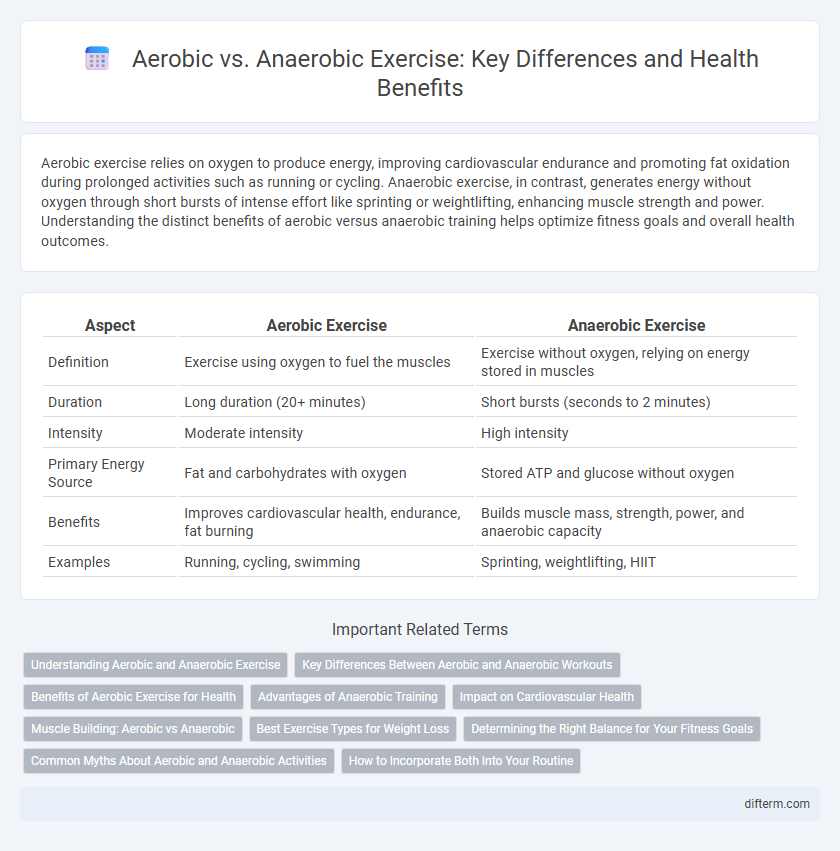Aerobic exercise relies on oxygen to produce energy, improving cardiovascular endurance and promoting fat oxidation during prolonged activities such as running or cycling. Anaerobic exercise, in contrast, generates energy without oxygen through short bursts of intense effort like sprinting or weightlifting, enhancing muscle strength and power. Understanding the distinct benefits of aerobic versus anaerobic training helps optimize fitness goals and overall health outcomes.
Table of Comparison
| Aspect | Aerobic Exercise | Anaerobic Exercise |
|---|---|---|
| Definition | Exercise using oxygen to fuel the muscles | Exercise without oxygen, relying on energy stored in muscles |
| Duration | Long duration (20+ minutes) | Short bursts (seconds to 2 minutes) |
| Intensity | Moderate intensity | High intensity |
| Primary Energy Source | Fat and carbohydrates with oxygen | Stored ATP and glucose without oxygen |
| Benefits | Improves cardiovascular health, endurance, fat burning | Builds muscle mass, strength, power, and anaerobic capacity |
| Examples | Running, cycling, swimming | Sprinting, weightlifting, HIIT |
Understanding Aerobic and Anaerobic Exercise
Aerobic exercise involves continuous, rhythmic activities like running, swimming, or cycling that increase oxygen intake and improve cardiovascular endurance by engaging large muscle groups over extended periods. Anaerobic exercise consists of high-intensity, short-duration activities such as sprinting, weightlifting, or high-intensity interval training (HIIT), where the body relies on energy sources stored in muscles without using oxygen. Understanding these differences helps optimize workout plans to enhance overall fitness, muscle strength, and endurance while improving metabolic health.
Key Differences Between Aerobic and Anaerobic Workouts
Aerobic workouts rely on oxygen to fuel continuous, low to moderate-intensity activity, promoting cardiovascular endurance and fat metabolism. Anaerobic workouts involve short bursts of high-intensity effort without oxygen, emphasizing muscle strength, power, and lactate buildup. Key differences include energy systems used, workout duration, intensity, and metabolic byproducts like carbon dioxide in aerobic and lactic acid in anaerobic exercises.
Benefits of Aerobic Exercise for Health
Aerobic exercise enhances cardiovascular health by improving heart and lung function, reducing the risk of chronic diseases such as hypertension and diabetes. It promotes weight management through sustained calorie burning and boosts mental well-being by releasing endorphins that reduce stress and anxiety. Regular aerobic activity also increases endurance and stamina, supporting overall physical fitness and longevity.
Advantages of Anaerobic Training
Anaerobic training enhances muscle strength and power by stimulating fast-twitch muscle fibers, leading to improved overall athletic performance and increased muscle mass. It boosts metabolic rate and promotes greater fat loss through excess post-exercise oxygen consumption (EPOC). This type of high-intensity exercise also improves cardiovascular health by increasing heart efficiency and resilience during short bursts of intense activity.
Impact on Cardiovascular Health
Aerobic exercise improves cardiovascular health by enhancing heart efficiency and increasing oxygen delivery through sustained activities like running and swimming. Anaerobic exercise, such as weightlifting or sprinting, strengthens the heart muscle and boosts metabolism by training the body to handle short bursts of intense effort. Both types of exercise support cardiovascular health by reducing blood pressure, improving cholesterol levels, and increasing overall cardiac function.
Muscle Building: Aerobic vs Anaerobic
Aerobic exercise primarily uses oxygen to generate energy, supporting endurance and fat burning, but it plays a limited role in muscle hypertrophy compared to anaerobic exercise. Anaerobic workouts, such as weightlifting and sprinting, rely on short bursts of high-intensity effort that create muscle tension and trigger muscle fiber growth through mechanisms like increased protein synthesis and satellite cell activation. Research shows anaerobic training significantly improves muscle mass and strength, making it the preferred approach for muscle building.
Best Exercise Types for Weight Loss
Aerobic exercises such as running, cycling, and swimming are highly effective for weight loss due to their ability to burn a significant amount of calories through sustained, moderate-intensity activity. Anaerobic exercises like weightlifting, sprinting, and high-intensity interval training (HIIT) enhance muscle mass and boost metabolism, promoting fat loss even at rest. Combining both aerobic and anaerobic workouts maximizes fat burning and improves overall body composition.
Determining the Right Balance for Your Fitness Goals
Aerobic exercise, characterized by sustained, moderate-intensity activities like running and cycling, enhances cardiovascular endurance and burns fat efficiently, while anaerobic exercise, including high-intensity interval training and weightlifting, builds muscle strength and improves metabolic rate. Determining the right balance depends on individual fitness goals, such as weight loss, muscle gain, or overall health improvement, with a tailored mix optimizing performance and recovery. Tracking metrics like heart rate zones, lactate threshold, and workout intensity can guide adjustments to maximize results and prevent overtraining.
Common Myths About Aerobic and Anaerobic Activities
Common myths about aerobic and anaerobic activities often mislead individuals regarding their effectiveness; aerobic exercises are widely believed to solely improve cardiovascular health, while anaerobic workouts are thought to only build muscle mass. In reality, aerobic activities like running and cycling also enhance muscular endurance, and anaerobic exercises such as sprinting and weightlifting significantly boost metabolic rate and fat loss. Understanding these nuances helps optimize fitness routines by blending both exercise types for comprehensive health benefits.
How to Incorporate Both Into Your Routine
Incorporate both aerobic and anaerobic exercises by scheduling cardio activities like running, cycling, or swimming three to five times weekly, aiming for at least 150 minutes of moderate-intensity aerobic exercise. Combine strength training or high-intensity interval training (HIIT) two to three times per week to target anaerobic muscles and improve power, endurance, and metabolism. Prioritize proper warm-up, post-workout stretches, and adequate rest to optimize recovery and prevent injuries.
Aerobic vs Anaerobic Infographic

 difterm.com
difterm.com